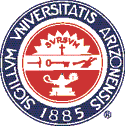
Document URL: http://www.cs.arizona.edu/classes/cs473/fall11/



C SC 473 |
Automata, Grammars and Languages |
| Class Meetings: |
This course is available in traditional lecture format, meeting twice
a week on
Tue & Thu 2:00-3:15, in the
Education (EDUC) Building
(just east of the 2nd St Parking Garage), in
Room 353.
|
Web Page |
The Web site for C SC473 is:
www.cs.arizona.edu/classes/cs473/fall11.
This document is the one you are reading now, and contains general
information about the course, policies, notes, assignments, schedule information, etc.
There is also a link to it on your D2L ``Course Home" page.
|
D2L |
Both the course Web page and the D2L pages for the course are accessible
to all students.
It is worth familiarizing yourself with the D2L pages for this course.
The D2L course page will be updated frequently, whereas, this page remains fairly static.
You are expected to visit your ``D2L Course Home" page regularly. You are responsbile
for all announcements made on the D2L course page.
Assignments, solutions, news, videos, etc. will only be made available on D2L course page.
|
About Video |
Lectures are not broadcast in real time. Instead lectures will be
recorded, processed and available for viewing through D2L a few hours after class.
These video recordings
will remain accessible for review throughout the semester.
|
Lecture Notes
|
Some of the lecture notes for this class are in PowerPoint form, which are divided into
sections; each section is called a ``Discourse". A Discourse typically
covers one or more class lectures.
PDF versions of these Discourses will be
placed on the D2L course page in advance of the lecture to which they are relevant.
These discourse are meant primarily as a supplementary source of material,
since
many of the slides in a discourse may not be covered explicitly during lecture.
Instead, most of the lecture material for this class will be given either on whiteboard or
make use of the document
camera, where the student is expected to take notes. The material covered in
this manner often will not be contained in the PDF slides.
Students that miss class can either
get a copy of another student notes or watch the class for that lecture.
|
Homework Standards |
All written work submitted for credit must be prepared
using a program that produces typeset output with
the appropriate type faces, symbols and
notation used in the theory of computation
(e.g., TeX, LaTeX, Word + MathType, etc).
Figures can be rendered
using a drawing tool like
xfig, Word,
paint, PowerPoint, etc. Students
are encouraged to use JFLAP to construct figures
whenever possible.
Do not submit scanned images of handwritten work.
The final product should be a PDF file that
can be emailed or retrieved for review.
That PDF should be printed on paper and submitted on the due date.
Students should also retain an electronic copy of their homework.
|
Rules for submitted work: Start each solution on a new page, repeat the problem statement, and number each page. Each page should list the name of the student and the possibly one or two other students with which they are working. Write on one side of the paper only. Write concise and clear solutions, since failure to communicate clearly will cost points whether or not the conclusion is correct. Remember that this is a Writing Emphasis Course, and work will be graded in part on the quality of your writing and ability to communicate. The grade will not depend only upon technical content. All homework solutions are due at the beginning of the class lecture on the due date. All good writing is based upon revision. It is essential to revise your work before submission, and to consider whether your argument will be understandable to the reader. For example, it is never a waste of effort to explain the strategy you intend to use in a proof or construction, before beginning to present the work in technical detail. Think of the reader. Explain as if teaching a colleague in your class. Revise. Revise again.
Reading Assignments
|
Reading assignments should be completed before the relevant
lecture on the subjects covered. Please see the D2L course page
for individual assignments.
|
In particular, a quiz may be given at the beginning of class that a particular reading assignment is due. Exams
|
Exams are administered as follows:
|
Information about forthcoming examinations (e.g., topics, example questions, rules for taking the exam) will appear here prior to the examination event. |